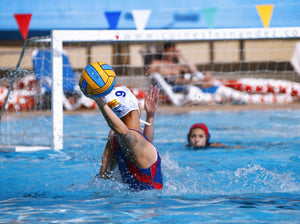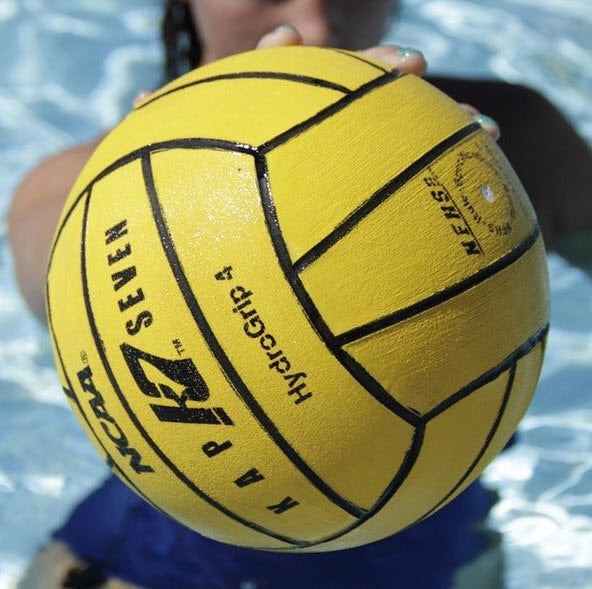How to Draw a Foul in Water Polo
Approach a pool where a water polo game is taking place and you’ll hear three tell-tale sounds: Coaches yelling from the pool deck, water splashing, and whistles. That last noise is probably because a foul is being called. Fouls occur regularly throughout a game of water polo. In fact, nearly every 30-second offense will see one or more fouls called. Below are some of the reasons fouls happen so often during a water polo game:
- There is no limit to the number of ordinary fouls a player can commit (of course, refs will take note if one player is committing an inordinate number).
- Players on defense foul to prevent shots on goal.
- Players on offense attempt to draw fouls to get free throws.
What is a Water Polo Foul?
An “ordinary” foul is a minor foul committed by one player, and is punished by awarding a free throw to the opposing team. Refs call a foul with a single tweet. That team then has three seconds to pass the ball or put it in play (signified by dropping the ball in the water and picking it back up). Both perimeter players and hole sets attempt to draw fouls as part of the offensive strategy.
An important detail to remember when drawing a foul is where you are in the water. If you are outside the five-meter mark, you have the option to shoot the ball in lieu of a free throw. The shot must come immediately after the foul is called. This means no faking or taking the shot after three seconds have passed.
Ejections are major fouls and result in a 20 second ejection of the offending player. Refs will call one of these fouls with three whistle blasts. Penalty fouls are called for even worse offenses like intentional violence or gross misconduct. They are punished with a free shot on goal from the five-meter line.
How to Draw a Foul
 Drawing an ordinary foul is an important skill, since it will come in handy any time a defender is pressuring you too hard to pass. The main thing to remember is that a foul will not be called while you are still holding on to the ball, so get used to protecting the ball with your body while letting it float on the water.
Drawing an ordinary foul is an important skill, since it will come in handy any time a defender is pressuring you too hard to pass. The main thing to remember is that a foul will not be called while you are still holding on to the ball, so get used to protecting the ball with your body while letting it float on the water.
The most common way to draw a foul in water polo is to try to turn your opponent while protecting the ball. If you can turn your opponent, you’ll have a straight shot to the goal. If you can’t turn them: Drop the ball, and a foul should be called.
- Turn your shoulder into your defender’s chest, forming a “T.”
- Hold the ball at arm’s length, on the surface of the water, and away from your defender. The ball should be out of your defender’s reach.
- Position your free arm under your defender, and attempt to turn them so that you have a clear path to the goal.
- Your defender will likely resist the turn. Drop the ball, and keep your body as a barrier between it and your defender until the foul is called. You may have to try to draw the foul several times before one is called.
Even if your main goal is to get a foul called, it should still look like you’re trying to get around your defender. Make your attempted turn look legitimate, but remember to control the ball.
If your defender is able to keep their hips and hands up, it’s going to be hard to get a foul called. You might have to grab a suit or an arm under the water to pull your defender closer to you. Be careful — if a ref notices, they will call an offensive foul and the ball will be turned over.
The Many Types of Fouls
According to water polo’s governing body Fédération Internationale de Natation (FINA), there are 15 types of ordinary fouls. While the foul described above is the most common during active play, it is important to be familiar with all possible foul calls. It is also worth remembering that although most fouls are called on defensive players, offensive fouls are still a possibility. Below is a summary of the different types of fouls that can be called during a water polo game.
Gaining Unfair Advantage
These fouls include holding or pushing off pool sides or goal posts, standing on the pool bottom during active play (does not apply to the goalie while within the five-meter area), or starting a period beyond the goal line. Players are also not allowed to take the entire ball under the water or to touch the ball with two hands at the same time (again, does not apply to the goalie).
Even if the ball has been forced underwater by a player other than the one holding of the ball, the foul will be called on the player who is in direct contact with it. This means that if your hand is on the ball and another player puts their hand on top of yours to force the ball underwater, the foul will be called on you.
Violence & Obstructing Movement
Water polo is an aggressive, physical game and refs will call fouls partly in order to regulate the violence. Players may not strike at the ball with a fist (does not apply to the goalie), or push off an opponent who does not have the ball. Impeding a player who does not have the ball can include swimming on their shoulders, back, or legs. This will result in a foul. Do not expect refs to call a foul on every single physical play, though.
Boundaries & Time Limits
Players may not be inside the two-meter line of their opponent's goal, except when they're also behind the line of the ball. Goalies may not touch the ball past the halfway line in the pool. If a ball goes outside the field of play, the player who last touched the ball will be punished for the foul. Free throws must be completed without delay (this will be at the discretion of the referees) and place (where the foul was originally called, or wherever the referee specifies). Lastly, one team may not retain possession of the ball for longer than 30 seconds of live play. This clock is reset after each attempted goal, turnover, or major foul.
Fouls Aren’t Bad
Yes, a foul signifies that someone has broken some rule, at some point. In many team sports, fouls are rare and have serious repercussions. New water polo players need to learn that fouls are an integral part of the game, and a necessary part of most offensive and defensive strategies. Work on drawing fouls in practice, and familiarize yourself with the various reasons fouls are called in the pool. You’re guaranteed to see that hard work pay off the next time your team has a game.



